Written by: HashKey Capital
How DAT Reshapes the Investment Landscape
In the past five years, from the American MicroStrategy to Japan's Metaplanet, and to dozens of publicly listed companies worldwide, the Digital Asset Treasury (DAT) model is gradually evolving from an individual phenomenon into a new trend in the capital markets. DAT companies incorporate digital assets such as Bitcoin and Ethereum into their balance sheets, not only reshaping the capital structure of enterprises but also providing investors with an alternative investment channel distinct from ETFs and funds.
This report, as the first in the "DAT Series," will guide readers through the basic concepts, development context, core characteristics, and differences from ETFs, while analyzing its strategic significance in the capital markets and the crypto ecosystem. Through data and case studies, we will see why an increasing number of companies choose to become "coin stocks" and how this model serves as a bridge between traditional finance and the digital asset world.
1. What is DAT
DAT refers to a business model where publicly listed companies allocate part or all of their treasury assets (such as cash and equivalents) to cryptocurrencies like Bitcoin and Ethereum, making this a core part of their strategy. It is not only an adjustment in asset allocation but also a strategic positioning of enterprises towards the future digital economy.
Against the backdrop of continuous inflow of institutional funds actively seeking digital asset allocation, Digital Asset Treasury Companies (DAT) have become an important narrative in the digital asset ecosystem. These companies are typically publicly listed and have publicly announced plans to hold significant amounts of digital assets as part of their long-term business strategy, making it a core part of their corporate strategy.
Cases like MicroStrategy, along with favorable policies from U.S. regulators, have jointly propelled the rapid development of digital asset treasury companies. An executive order signed by former President Trump officially allowed the establishment of strategic Bitcoin reserves; at the same time, institutional investors can now measure digital asset holdings at fair value, allowing digital asset strategies to be recognized and verified on corporate balance sheets. Driven by these favorable factors, market demand has quickly followed. Geographically, the U.S. is the largest market for these treasury companies. These companies also need to comply with strict capital reporting requirements and must work closely with regulated custodians, cryptocurrency exchanges, and market makers to successfully execute related strategies. Other regions are also following closely, with Asian companies adopting a more cautious approach, seeking a balance between risk appetite and regulatory robustness.
Currently, most treasury companies primarily hold Bitcoin and Ethereum, but some institutions are beginning to invest in other emerging high-quality assets, such as Solana, XRP, HYPE, and SUI. According to publicly available data, publicly listed companies collectively hold 1,011,352 Bitcoins, accounting for about 5% of the total Bitcoin supply, with MicroStrategy being the largest holder. Since 2025, the corporate holding of Bitcoin has doubled. Meanwhile, Ethereum treasury companies collectively hold about 3.88 million ETH, accounting for approximately 4.34% of the total Ethereum supply.
2. Brief History and Current Development of DAT
The initial form of DAT began with Bitcoin as the underlying asset. In December 2020, MicroStrategy announced that its total Bitcoin purchases in 2020 exceeded $1 billion, thus starting the DAT journey. Over the past five years, MicroStrategy has made several increases in Bitcoin holdings through its own cash, issuing bonds, and issuing stocks. Data shows that as of September 16, MicroStrategy holds a total of 638,985 Bitcoins, making it the company with the highest Bitcoin holdings.
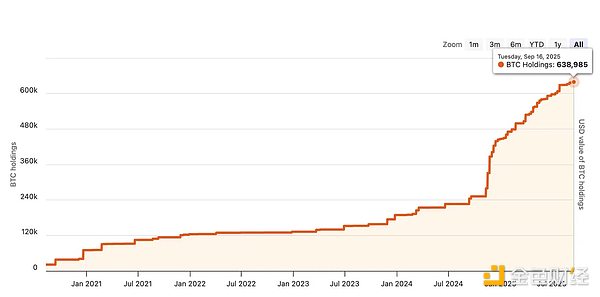
Chart of MicroStrategy's Bitcoin holdings. Source: Bitcointreasuries.net
According to MicroStrategy's Bitcoin accumulation data, in the first four years, MicroStrategy increased its Bitcoin holdings at a rate of less than 100,000 Bitcoins per year, with the accumulation exceeding 200,000 in 2024, and approaching 200,000 Bitcoins in 2025.
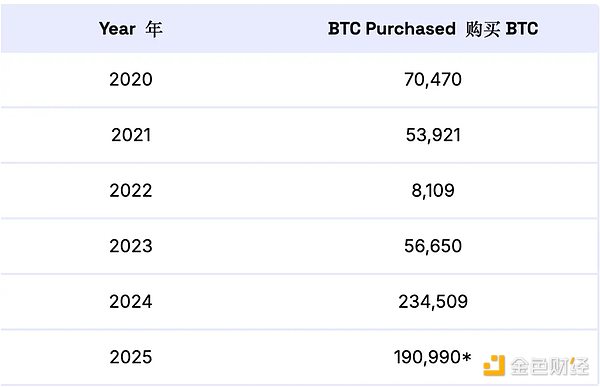
Annual BTC purchases. Source: MicroStrategy — Bitcoin Holdings Timeline (Annual Growth)
From the development of company-held BTC (as shown below), in addition to MicroStrategy's annual increases in Bitcoin, an increasing number of companies are joining in holding Bitcoin. Reports indicate that the number of publicly listed companies holding Bitcoin increased by 64 from the end of 2024 to the first half of 2025, with a total of 190 publicly listed companies and 64 non-listed companies currently holding or having held Bitcoin, with total holdings of 1,011,352 and 299,207 Bitcoins, respectively.
The historical trend chart of Bitcoin holdings shows that the growth of Bitcoin holdings among publicly listed companies jumped at the beginning of 2021 and the end of 2024, primarily driven by several operations from MicroStrategy. The Bitcoin holdings of non-listed companies surged in the second half of 2022, mainly driven by Block.one publicly holding 164,000 Bitcoins in September of that year.

The distribution of Bitcoin over time, Source: Bitcointreasuries.net
These Bitcoin-holding companies span multiple countries, as shown in the data chart, with half of the publicly listed companies coming from the U.S. and Canada, and nearly half of the non-listed companies from the U.S.
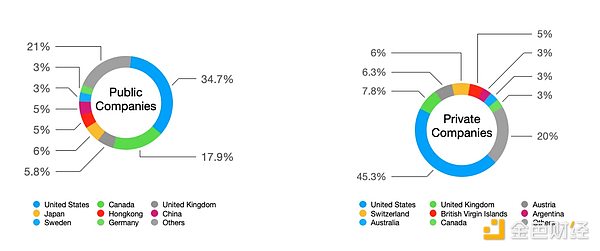
Distribution of Bitcoin-holding companies by country. Source: Bitcointreasuries.net; Compiled by HashKey Capital.
It can be seen that the development of Bitcoin DAT features multiple companies, multiple regions, and steady growth.
Over the past five years, the differentiation of target assets in DAT has gradually become apparent, gradually including digital assets beyond BTC, such as ETH and SOL, which are mostly high-market-cap mainstream altcoins. Ethereum DAT began in April of this year and has rapidly grown nearly twofold in July and August.
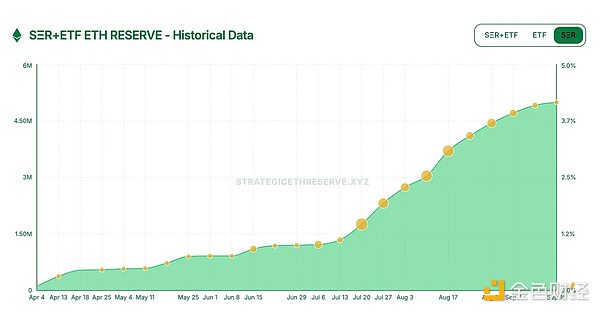
Trend chart of Ethereum DAT holdings, Source: strategicetherreserv
Compared to Bitcoin DAT, the main entities of Ethereum-based DAT are statistically 17, holding a total of 3.88M ETH. Among the 17 Ethereum-holding entities, 15 are publicly listed companies, 1 is preparing to go public, and 1 is an on-chain protocol. Among the publicly listed companies, there are 12 from the U.S. and 3 from Hong Kong, China. This distribution shows a significant difference compared to Bitcoin DAT, especially with the presence of the on-chain protocol ETH Strategy, whose token STRAT is issued on Uniswap. This situation arises from the technical differences between Ethereum and Bitcoin, as Ethereum's smart contracts allow for the construction of complex DApps, leading to a richer ecosystem.
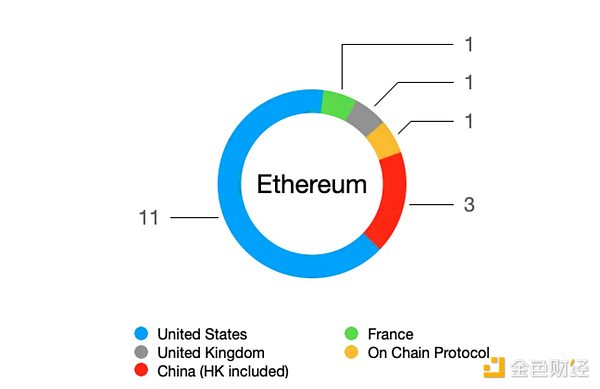
Ethereum holdings by country and region, Source: strategicetherreserve, compiled by HashKey Capital.
Following closely is Solana, with data from Coingecko showing that a total of 8 publicly listed entities hold it, distributed across three countries.
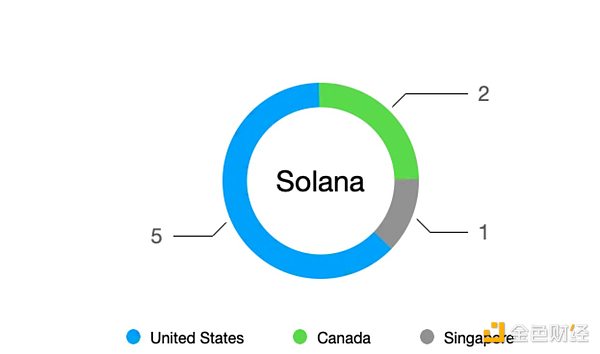
Solana's holdings (by country/region), Source: strategicetherreserve, compiled by HashKey Capital.
The main companies with DAT targeting Bitcoin, Ethereum, and Solana are currently the three mainstream directions, with relevant information summarized as follows:

Data as of 2025/09/15. The entities holding BTC include those that previously held it and currently have 0 holdings, excluding ETFs, DAO treasuries, etc. The comparison statistics of the three major DAT categories based on BTC, ETH, and SOL as underlying assets are sourced from: Bitcointreasuries.net, strategicetherreserve, and compiled by HashKey Capital.
From the table, it can be seen that the number of entities holding BTC is far greater than those holding Ethereum and Solana, reaching 15 times and 30 times respectively. This phenomenon indicates that most DAT companies choose Bitcoin as their target, showcasing Bitcoin's unique position in the cryptocurrency world.
Further analysis of the holding proportions reveals that among the DAT companies holding BTC, the largest holder, MicroStrategy, accounts for 49%, significantly higher than the second-largest holder at 13%. MicroStrategy's absolute share and high BTC volume conceal certain risks; as a market barometer, any actions or phenomena such as selling Bitcoin or being unable to continue the DAT strategy could pose a significant threat to the market. For ETH, the largest holder's share is even higher at 55%, while the second-largest also reaches 21%, with the top three accounting for 90%, indicating a structural imbalance. In contrast, for SOL, the top three entities each hold an average of 30%, resulting in a balanced market structure.
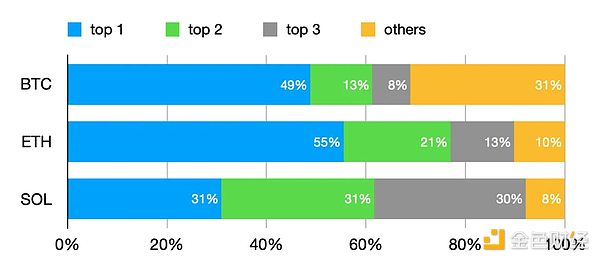
Comparison of the holding distribution of the three major DAT categories based on BTC, ETH, and SOL as underlying assets. Source: Bitcointreasuries.net, strategicetherreserve, compiled by HashKey Capital.
In addition to BTC, ETH, and SOL as target assets, DAT also involves other assets such as public chain assets TRX, SUI, XRP, exchange platform tokens BNB, decentralized contract platform tokens HYPE, and the Trump family platform token WLFI, among others. The scale of these DAT-held target assets ranges from $300M to $2B. This phenomenon continues to intensify into the third quarter of 2025, and we expect more DATs to emerge with other assets as targets.
In addition to the aforementioned single-asset purchase strategy, DAT companies targeting multiple assets are gradually emerging, or they are adjusting their target asset allocations. For example, Lion Group (LGHL) announced in September that it would convert all its SUI and SOL into HYPE. Additionally, these DAT companies have begun to invest in each other, such as Nakamoto Holdings (NASDAQ: NAKA)'s subsidiary KindlyMD announcing a commitment to invest in the Japanese Bitcoin reserve company Metaplanet's international equity financing.
3. Characteristics of DAT
Whether single-asset or multi-asset DAT companies, compared to traditional companies, ETFs, and other publicly traded financial products, DAT as an emerging business model has very distinct characteristics:
Strategic Transparency
Companies must publicly announce their DAT strategies and regularly disclose their holdings. This commitment is the foundation for gaining market trust and premium. For example, since implementing its BTC reserve strategy, MicroStrategy has released dozens of purchase announcements, transparently showing shareholders the changes in holdings. It has also introduced a new metric, "Bitcoin Yield," to measure the percentage growth of BTC held per share. This practice reflects the self-restraint of DAT companies through a long-term holding strategy and acceptance of public oversight, which not only attracts investors who prefer this strategy but also provides the market with a clear understanding of the company's risks.
Ecological Synergy
The fate of DAT companies is deeply tied to the ecosystem of the crypto assets they hold. When a company holds a large amount of a certain token, it effectively becomes a major stakeholder in that blockchain ecosystem, thus motivated to invest resources to promote the ecosystem's development. For example, the aforementioned BitMine company holds a massive amount of Ethereum and actively participates in staking on the Ethereum network to help maintain network security while earning additional income. The company's growth and the prosperity of the ecosystem form a positive cycle—token appreciation benefits the company, and the company's growth further supports the ecosystem. This synergy helps build a value closed loop: DAT investors and project communities achieve a "win-win," promoting the long-term sustainable development of the entire digital asset ecosystem.
Compliance Evolution
With changes in the regulatory environment, the DAT model itself is gradually becoming institutionalized and compliant. In the early days, direct holding of cryptocurrencies by companies was often seen as an anomaly, and the impact of high-volatility assets on financial reports caused headaches for traditional auditors. However, now accounting standards and regulatory policies are adapting to this trend. DAT companies listed in the U.S. must meet strict auditing and capital adequacy requirements, use regulated custodians to hold digital assets, and comply with anti-money laundering and information disclosure regulations. At the same time, new products like Bitcoin ETFs provide more compliant investment alternatives but also force DAT companies to enhance their operational standards to stand out in competition. It is foreseeable that the operations of DAT will increasingly resemble those of mainstream financial institutions—enjoying the growth dividends of crypto assets while adhering to sound risk management and compliance frameworks.
4. Comparison with Other Financial Instruments
When assessing the investment value of DAT, a core perspective is to compare it within a broader spectrum of financial instruments. We selected three methods: direct investment in cryptocurrencies, cryptocurrency spot ETFs, and DAT company stocks, analyzing them across four key dimensions: liquidity efficiency, risk-return characteristics, leverage structure, and downside protection (see the table below). Our analysis indicates that DAT is not a simple substitute for the first two but rather a more advanced, hybrid tool that integrates equity and crypto asset characteristics, providing professional investors with a unique source of Alpha returns.
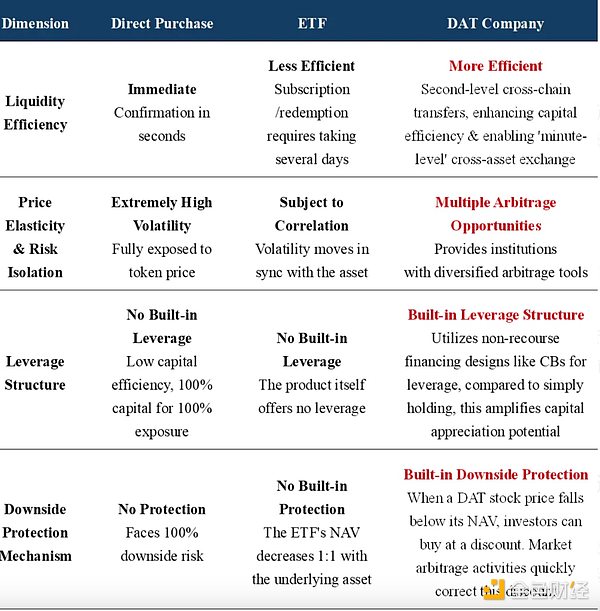
Beyond Beta: Seeking Structural Alpha
The core of direct investment and ETF investment is to obtain the Beta returns of cryptocurrencies, which is the fundamental market return. However, the investment logic of DAT transcends Beta, with its core appeal lying in obtaining structural Alpha returns.
For direct holders, their return curve closely aligns with the price of the coin, representing a pure but passive risk exposure.
For ETF investors, although they gain compliance and convenience, their return model essentially remains "coin price minus management fees," failing to escape the realm of Beta.
For DAT investors, their sources of returns are diversified: they include not only the appreciation of the underlying crypto assets but also primary market discounts, smart leverage utilization, cross-market arbitrage, and premiums arising from the management team's execution capabilities. This Alpha does not stem from market volatility but from the intrinsic value creation ability of the unique capital structure of DAT.
Upgraded Risk Management Dimension: From Passive Acceptance to Active Utilization
Traditional risk perceptions view volatility as something to be avoided. DAT offers a new perspective: transforming volatility into a manageable resource or even a source of profit. Direct investors and ETF investors are nearly powerless in a declining market, having to passively accept drawdowns. In contrast, the complex capital structure of DAT provides multidimensional risk management tools. The changes in the premium or discount between its stock price and NAV provide arbitrage opportunities for the market, and this arbitrage behavior itself becomes a mechanism for stabilizing prices.
By issuing non-redeemable long-term debt (such as convertible bonds), DAT companies can amplify returns in a bull market, while in a bear market, their debt structure provides a buffer, avoiding the risk of forced liquidation due to margin calls.
When the DAT stock price falls below its net asset value (mNAV1) due to market panic, this will attract value investors and arbitrageurs to enter the market, forming an inherent "safety net" mechanism, which is a dynamic risk adjustment capability that the other two investment methods completely lack.
In summary, DAT should not be simply understood as "an alternative way to invest in cryptocurrencies." In fact, DAT is a unique, self-contained asset class. Therefore, for professional investors and institutions seeking higher capital efficiency, richer strategic tools, and more proactive risk management methods, DAT is not an option but a necessity. It represents not a substitute for the past but an upgrade to the future investment paradigm. As Dr. Xiao Feng, founder of HashKey Group, stated: "ETFs are good, but DAT is better." Its superiority lies in its ability to create Alpha returns that cannot be replicated by traditional financial instruments, which is inherent in its structure.
5. Significance of DAT
As a new vehicle connecting the traditional financial world with the crypto world, the emergence of digital asset treasury companies has significant implications in multiple aspects.
DAT is a Bridge for Traditional Investors to Enter the Crypto Ecosystem
Similar to ETFs, DAT companies build a bridge for investors who cannot or prefer not to hold cryptocurrencies directly. However, the operational model of DAT is more flexible than that of ETFs, as many institutional investors (such as public funds and pensions in certain countries) are restricted by regulations from directly purchasing Bitcoin or related ETFs but can buy stocks of overseas-listed companies. Therefore, the DAT structure can expand the potential investor base for cryptocurrency investments and help traditional capital enter the digital asset ecosystem while complying with local regulations and investment policies.
Some notable corporate allocations—such as MicroStrategy's initial purchase of Bitcoin—have also attracted widespread attention from corporate finance departments, brokers, and other financial institutions, thereby promoting greater participation of institutional investors in digital assets. In this sense, DAT companies serve as a bridge between traditional capital markets and the cryptocurrency ecosystem, normalizing cryptocurrency exposure in institutional portfolios.
Empowering the Blockchain Ecosystem to Achieve a Value Closed Loop
The emergence of digital asset treasury companies also introduces a powerful new source of funding for crypto project ecosystems, helping projects achieve internal value circulation. On one hand, DAT companies continuously purchase coins in the secondary market and lock them up for the long term, objectively reducing the circulating supply of tokens, which helps maintain price stability and appreciation, thereby supporting the value of the project ecosystem from the market level.
On the other hand, due to holding a large amount of a certain project's tokens, these companies are highly aligned with the project's official interests (foundations), both hoping for ecological prosperity and rising token prices. Managers will contribute the tokens they hold to the areas of the ecosystem that need them most, such as participating in staking on PoS chains to enhance network security, lending tokens to DeFi protocols to provide liquidity, or even investing in startups within the ecosystem to support practical applications. This growth flywheel can empower the ecosystem more efficiently, achieving a win-win for DAT investors and the ecosystem.
Refocusing on Long-Term Value Amid Short-Term Volatility
The DAT model also guides the market's focus from short-term speculation to long-term value creation. Under traditional views, cryptocurrency companies are often labeled as "speculative" and "highly volatile," with investors eager to guess short-term price fluctuations. However, treasury companies clearly state that their core financial goal is the net asset value per share corresponding to digital assets, rather than chasing short-term price volatility. This means that management is more concerned with how many coins can be held over several years and how much the intrinsic value of the coins can grow, rather than buying and selling positions arbitrarily for quarterly profits and losses.
When the market begins to view DAT companies through the lens of value investing, the entire ecosystem's valuation system also tends to mature and stabilize. Long-term investors (such as value-oriented funds) are more likely to join, enhancing the stability of the investor structure and reducing the volatility of stock and token prices. In other words, the DAT model helps redirect attention from "pure speculation" to discussions about "long-term asset appreciation potential." It prompts investors to consider: will the Bitcoin/Ethereum held by this company be worth more in five or ten years due to the development of the ecosystem? If the answer is yes, then short-term price corrections are not to be feared. This shift in mindset helps cultivate more long-term thinkers in the digital asset space, thereby enhancing the robustness and health of the entire industry's valuation.
Conclusion
Digital Asset Treasury (DAT) companies, as a product of the intersection between traditional finance and the digital asset world, are playing multiple roles as a bridge, enabler, and anchor. On one hand, they open the door for traditional capital to participate in crypto, expanding the capital pool and recognition of the crypto market; on the other hand, their existence is also pushing the crypto ecosystem towards greater maturity—whether in enhancing compliance or emphasizing long-term fundamentals. The rise of such companies reflects a microcosm of the digital economy's transformation: an increasing number of enterprises are beginning to view digital assets as strategic resources to allocate and operate.
In the next report of this series, we will focus on how DAT companies specifically issue and operate, and from the investor's perspective, how to judge and evaluate the investment value of DAT companies.
免责声明:本文章仅代表作者个人观点,不代表本平台的立场和观点。本文章仅供信息分享,不构成对任何人的任何投资建议。用户与作者之间的任何争议,与本平台无关。如网页中刊载的文章或图片涉及侵权,请提供相关的权利证明和身份证明发送邮件到support@aicoin.com,本平台相关工作人员将会进行核查。



